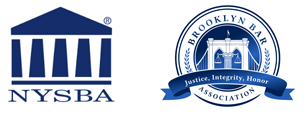In Lee v Leeds, Morelli & Brown, P.C., 233 AD3d 1072, 1075-76 [2d Dept 2024], the court held that:
“The death of a party divests the court of jurisdiction and stays the proceedings until a proper substitution has been made pursuant to CPLR 1015(a)[, and] any determination rendered without such substitution will generally be deemed a nullity” (Singer v. Riskin, 32 A.D.3d 839, 839–840, 821 N.Y.S.2d 120 [citations omitted]; see Hemmings v Rolling Frito–Lay Sales, LP, 220 A.D.3d 754, 757, 197 N.Y.S.3d 561; Vicari v. Kleinwaks, 157 A.D.3d 975, 976, 70 N.Y.S.3d 532). Here, the Supreme Court erred in considering the separate motions of the LMB defendants and Bear Stearns pursuant to CPLR 3211(a) to dismiss the complaint insofar as asserted against each of them because the motions were made after Roe’s death and prior to any substitution of a personal representative of his estate (see id. § 1015; Matter of Einstoss’ Estate, 26 N.Y.2d 181, 309 N.Y.S.2d 184, 257 N.E.2d 637; Neuman v. Neumann, 85 A.D.3d 1138, 1139, 926 N.Y.S.2d 632; Manto v. Cerbone, 71 A.D.3d 1099, 1100, 898 N.Y.S.2d 182). Accordingly, so much of the order dated January 8, 2020, as granted the separate motions of the LMB defendants and Bear Stearns pursuant to CPLR 3211(a) to dismiss the complaint insofar as asserted against each of them must be vacated as a nullity (see CPLR 1015; Matter of Einstoss, 26 N.Y.2d 181, 309 N.Y.S.2d 184, 257 N.E.2d 637; Neuman v. Neumann, 85 A.D.3d 1138, 926 N.Y.S.2d 632), and the appeal taken by the plaintiff Cheryl Lee from so much of the order dated September 30, 2020, as, upon reargument, adhered to the determination in the order dated January 8, 2020, granting those branches of the LMB defendants’ motion which were pursuant to CPLR 3211(a) to dismiss the first, third, and sixth causes of action must be dismissed.
Furthermore, the death of a party also terminates an attorney’s authority to act on behalf of the deceased party (see Vicari v. Kleinwaks, 157 A.D.3d at 976, 70 N.Y.S.3d 532; Vapnersh v. Tabak, 131 A.D.3d 472, 474, 15 N.Y.S.3d 131; Lewis v. Kessler, 12 A.D.3d 421, 422, 784 N.Y.S.2d 574). Thus, Roe’s former attorneys lacked the authority to file either the cross-motion or this appeal on his behalf. Accordingly the appeal purportedly taken on Roe’s behalf must be dismissed (see Vicari v. Kleinwaks, 157 A.D.3d 975, 70 N.Y.S.3d 532).
Richard A. Klass, Esq.
Your Court Street Lawyer
keywords:
#CourtStreetLawyer #legalmalpractice #newyork #litigation #death
Richard A. Klass, Esq., maintains a law firm engaged in civil litigation at 16 Court Street, 28th Floor, Brooklyn, New York. He may be reached at (718) COURT●ST or RichKlass@courtstreetlaw.comcreate new email with any questions.
Prior results do not guarantee a similar outcome.
© 2025 Richard A. Klass






